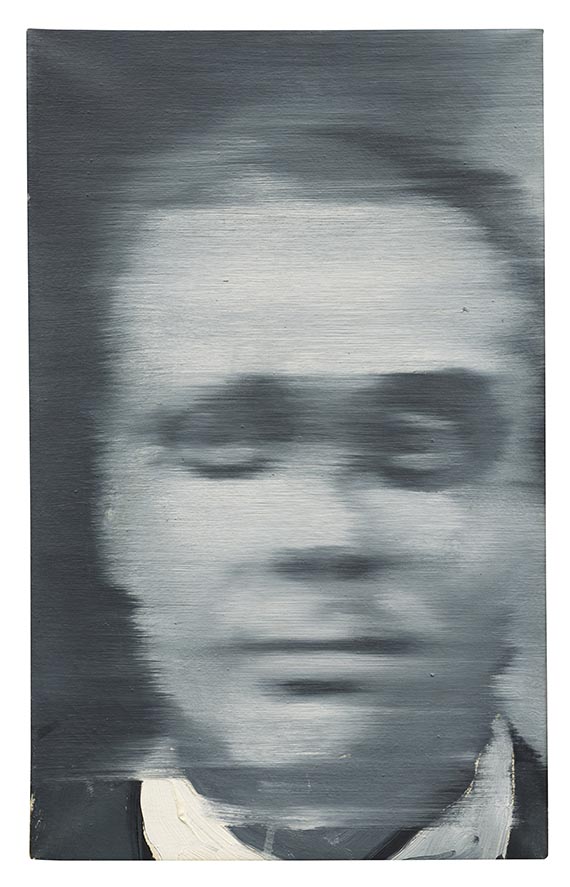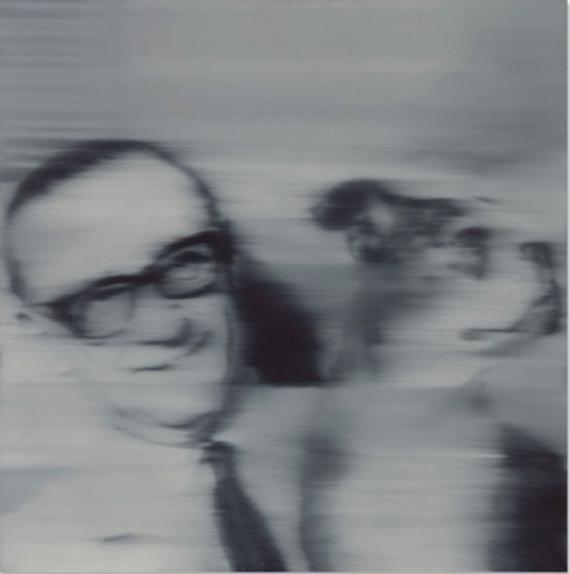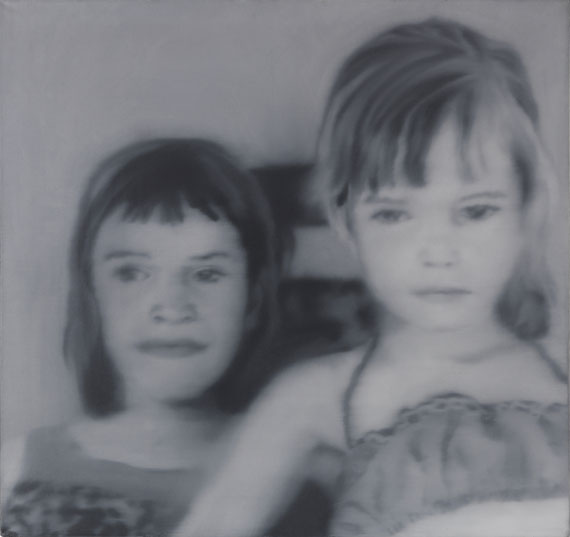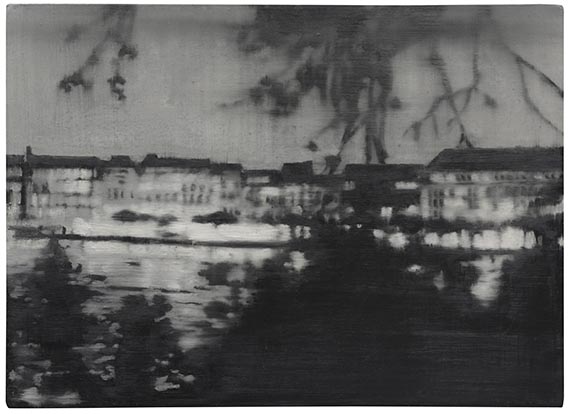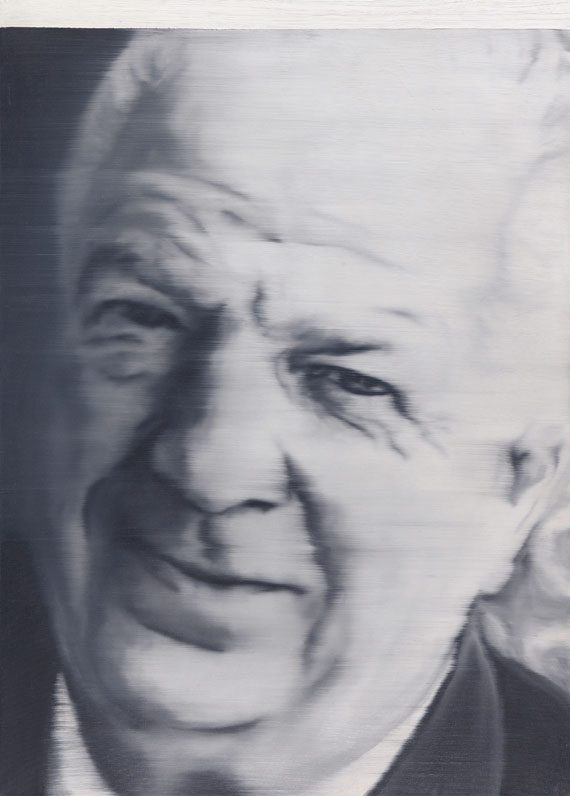Vente: 550 / Evening Sale 07 juin 2024 à Munich  Lot 124000618
Lot 124000618
 Lot 124000618
Lot 124000618
124000618
Gerhard Richter
Herr Uecker, 1964.
Oil on canvas
Estimation: € 450,000 / $ 481,500
Les informations sur la commission d´achat, les taxes et le droit de suite sont disponibles quatre semaines avant la vente.
Herr Uecker. 1964.
Oil on canvas.
Signed, titled "Herr Uecker" and inscribed with the dimensions on the reverse. Stretcher titled "Herr Uecker". 47 x 29 cm (18.5 x 11.4 in).
• Richter paints “Herr Uecker” - one of the early important Richter portraits.
• The first artist portrait in Richter's oeuvre and the only painterly testimony to their joint artistic breakthrough in Düsseldorf.
• The composition of “Herr Uecker” gains particular tension from the balance between the slightly inpainted areas and the blank parts in the lower margin.
• Shown in the legendary exhibition “Neue Realisten” at Galerie Parnass, Wuppertal, in 1964, and most recently in the major exhibition “Gerhard Richter. Bilder einer Epoche” (Hamburg 2011).
• Comparable portraits from the 1960s can be found in, among others, the Museum of Modern Art, New York, the San Francisco Museum of Modern Art and the Museum of Contemporary Art, Tokyo.
We are grateful to Dr. Dietmar Elger, Director of the Gerhard Richter Archive at the Staatliche Kunstsammlumngen Dresden, for his kind support in cataloging this lot.
PROVENANCE: Galerie René Block, Berlin (directly from the artist in 1965).
Block Collection, Berlin.
Private collection Berlin (since 1995).
EXHIBITION: Neue Realisten. Konrad Lueg, Sigmar Polke, Gerd Richter, Galerie Parnass, Wuppertal, November 20 - December 30, 1964.
Models of Reality. Approaches to Realism in Modern German Art, Harris Museum and Art Gallery, Preston/Lancashire, May 18 - July 6, 1991; Ferens Museum and Art Gallery, Hull, July 20 - September 1, 1991.
Mit dem Kopf durch die Wand und etwas Neues finden. Sammlung Block, Statens Museum for Kunst, Copenhagen, May 7 - August 30, 1992; Nykytaiteen Museo, Helsinki, October 30, 1992 - January 3, 1993; Listasafn Islands, Reykjavík, 1993; Kunsthalle Nürnberg, 1993, p. 51 (ill.). Wuppertal 1996, p. 51 (illu. on p. 262).
Gerhard Richter. Billede efter billede, Louisiana Museum of Modern Art, Humlebæk, February 4 - May 29, 2005, p. 17 (illu.).
Gerhard Richter. Portraits, Museumsberg, Flensburg, May 7 - July 9, 2006, pp. 95f. (illu. on p. 25).
Gerhard Richter. Bilder einer Epoche, Bucerius Kunst Forum, Hamburg, February 5 - May 15, 2011, p. 201, cat. no. 29 (illu. on p. 146 and p. 201).
LITERATURE: Dietmar Elger, Gerhard Richter. Catalogue raisonné, vol. 1 (1962-1968), Ostfildern 2011, p. 200, no. 80-17 (illu.).
Gerhard Richter. Werkübersicht / Catalogue raisonné 1962-1993, Kunst- und Ausstellungshalle der Bundesrepublik Deutschland, Bonn et al, vol. III, Ostfildern-Ruit 1993 (illu., nos. 80-17).
- -
Gerhard Richter, 36th Venice Biennale (German Pavilion), Essen 1972, p. 38 (not illu.).
Kunstforum International, nos. 6/7, 1973 (illu., on p. 120).
Exhib. cat. Gerhard Richter. Bilder 1962-1985, Städtische Kunsthalle, Düsseldorf, Stuttgart et al. 1986, p. 36 (illu.).
Exhib. cat. Mit dem Kopf durch die Wand . und etwas Neues finden. Fluxus aus der Sammlung René Block, Kunsthalle Barmen / Kunst- und Museumsverein, Wuppertal 1996, p. 51 (illu. on p. 262).
Exib. cat. Gerhard Richter Portraits. Painting Appearances, National Portrait Gallery, London 2009, p. 114 (illu. On p. 116).
Paul Moorhouse (ed.), Die Porträts von Gerhard Richter, Cologne 2009, p. 114 (illu. On p. 116).
Emanuele Garbin, Il bordo del mondo. La forma sguardo nella pittura di Gerhard Richter (PhD thesis), Venice 2011, pp. 40 and 41 (illu. on p. 205).
Günther Uecker, 2016, about the time with Gerhard Richter and Sigmar Polke
Oil on canvas.
Signed, titled "Herr Uecker" and inscribed with the dimensions on the reverse. Stretcher titled "Herr Uecker". 47 x 29 cm (18.5 x 11.4 in).
• Richter paints “Herr Uecker” - one of the early important Richter portraits.
• The first artist portrait in Richter's oeuvre and the only painterly testimony to their joint artistic breakthrough in Düsseldorf.
• The composition of “Herr Uecker” gains particular tension from the balance between the slightly inpainted areas and the blank parts in the lower margin.
• Shown in the legendary exhibition “Neue Realisten” at Galerie Parnass, Wuppertal, in 1964, and most recently in the major exhibition “Gerhard Richter. Bilder einer Epoche” (Hamburg 2011).
• Comparable portraits from the 1960s can be found in, among others, the Museum of Modern Art, New York, the San Francisco Museum of Modern Art and the Museum of Contemporary Art, Tokyo.
We are grateful to Dr. Dietmar Elger, Director of the Gerhard Richter Archive at the Staatliche Kunstsammlumngen Dresden, for his kind support in cataloging this lot.
PROVENANCE: Galerie René Block, Berlin (directly from the artist in 1965).
Block Collection, Berlin.
Private collection Berlin (since 1995).
EXHIBITION: Neue Realisten. Konrad Lueg, Sigmar Polke, Gerd Richter, Galerie Parnass, Wuppertal, November 20 - December 30, 1964.
Models of Reality. Approaches to Realism in Modern German Art, Harris Museum and Art Gallery, Preston/Lancashire, May 18 - July 6, 1991; Ferens Museum and Art Gallery, Hull, July 20 - September 1, 1991.
Mit dem Kopf durch die Wand und etwas Neues finden. Sammlung Block, Statens Museum for Kunst, Copenhagen, May 7 - August 30, 1992; Nykytaiteen Museo, Helsinki, October 30, 1992 - January 3, 1993; Listasafn Islands, Reykjavík, 1993; Kunsthalle Nürnberg, 1993, p. 51 (ill.). Wuppertal 1996, p. 51 (illu. on p. 262).
Gerhard Richter. Billede efter billede, Louisiana Museum of Modern Art, Humlebæk, February 4 - May 29, 2005, p. 17 (illu.).
Gerhard Richter. Portraits, Museumsberg, Flensburg, May 7 - July 9, 2006, pp. 95f. (illu. on p. 25).
Gerhard Richter. Bilder einer Epoche, Bucerius Kunst Forum, Hamburg, February 5 - May 15, 2011, p. 201, cat. no. 29 (illu. on p. 146 and p. 201).
LITERATURE: Dietmar Elger, Gerhard Richter. Catalogue raisonné, vol. 1 (1962-1968), Ostfildern 2011, p. 200, no. 80-17 (illu.).
Gerhard Richter. Werkübersicht / Catalogue raisonné 1962-1993, Kunst- und Ausstellungshalle der Bundesrepublik Deutschland, Bonn et al, vol. III, Ostfildern-Ruit 1993 (illu., nos. 80-17).
- -
Gerhard Richter, 36th Venice Biennale (German Pavilion), Essen 1972, p. 38 (not illu.).
Kunstforum International, nos. 6/7, 1973 (illu., on p. 120).
Exhib. cat. Gerhard Richter. Bilder 1962-1985, Städtische Kunsthalle, Düsseldorf, Stuttgart et al. 1986, p. 36 (illu.).
Exhib. cat. Mit dem Kopf durch die Wand . und etwas Neues finden. Fluxus aus der Sammlung René Block, Kunsthalle Barmen / Kunst- und Museumsverein, Wuppertal 1996, p. 51 (illu. on p. 262).
Exib. cat. Gerhard Richter Portraits. Painting Appearances, National Portrait Gallery, London 2009, p. 114 (illu. On p. 116).
Paul Moorhouse (ed.), Die Porträts von Gerhard Richter, Cologne 2009, p. 114 (illu. On p. 116).
Emanuele Garbin, Il bordo del mondo. La forma sguardo nella pittura di Gerhard Richter (PhD thesis), Venice 2011, pp. 40 and 41 (illu. on p. 205).
Günther Uecker, 2016, about the time with Gerhard Richter and Sigmar Polke
Our perception of Gerhard Richter's painterly oeuvre was formed by both his sought-after early black-and-white works from the 1960s, as well as by the "Abstract Paintings" that he began in 1976. Family photos, advertising pictures and pieces from other print media provide the basis for Richter's portraits and cityscapes of these years. Richter subsequently “inpainted” the motifs in an enlarged canvas format, dissolving their contours into soft black-and-white modulations. Works from the early 1960s are characterized by the famous blurring that would become Richter's artistic trademark.
Richter's portrait of fellow artist and friend Günther Uecker, the famous ZERO protagonist, was made in 1964 in the context of a small series of portraits initiated by the legendary Düsseldorf gallerist owner Alfred Schmela for Richter's first solo exhibition in September 1964. “Herr Uecker” is one of the last early Richter portraits that is still privately owned today. Richter created this fascinating painting on the basis of a vernissage photo showing Günther Uecker and Schmela, which also served as inspiration for two versions of “Potrait Schmela” from the same year. The series of eight portraits from 1964 began with three portraits of Alfred Schmela himself, of which one is based on passport photos while the other two follow the abovementioned exhibition shots. They were supposed to serve as a kind of sample for the gallery's potential customers. The first version of “Portrait Schmela” (Elger 37-1) was sold by Sotheby's London for a little more than 4.6 million euros in 2015. Another version (Elger 37-3) became part of the collection 'Kunstsammlungen Nordrhein-Westfalen' in the summer of 2014 as a widely covered million-euro endowment from the art historian Viktoria von Flemming. In addition to two versions of “Portrait Dr. Knobloch”, the Krefeld gynecologist and collector Dr. Gisela Knobloch, one of which was purchased by the Staatliche Kunstsammlungen Dresden in 2009, and the other is believed to have been destroyed (cf. the catalogue raisonné), Richter also created a total of three versions of "Portrait Schniewind", showing the Düsseldorf collector Willy Schniewind. Our house successfully sold one of these three works to an Asian private collection in 2018, while Sotheby's London had already sold another version in 2010 with a similar result. Günther Uecker, Richter's artist friend, and ZERO founder, originally owned the third version of “Potrait Schniewind”, which is now part of the renowned Fisher Collection, one of the largest private collections of American and German art after 1960, housed at the Museum of Modern Art in San Francisco.
Richter's and Uecker's artistic breakthrough is closely associated with the legendary Düsseldorf gallery owner Alfred Schmela, who not only organized Gerhard Richter's first solo exhibition in 1964 but was also responsible for Günther Uecker's first solo exhibition in Germany in 1961. On top of that, he made a name for himself with early exhibitions of Lucio Fontana. By 1964, Uecker had already staged nine “ZERO” exhibitions, including the incredible show at Howard Wise in New York, which heralded the 34-year-old artist's international breakthrough. After various art and exhibition projects with, among others, Sigmar Polke and Blinky Palermo, which also included the legendary show "Leben im Museum" at the Kunsthalle Baden-Baden in 1968, Gerhard Richter represented Germany at the 1972 Biennale with his famous series of “48 Portraits”, showing 48 European intellectuals. The portrait “Herr Uecker” was also first published in the Biennale catalog. Richter's first documenta participation followed in 1972, eventually leading to his first solo exhibition in New York in 1973.
Richter's portrait “Herr Uecker” is not only one of these particularly early Richter portraits from 1964, but also a fascinating and unique testimony to the joint artistic breakthrough of these two important German artists. In 1979, the British artist Richard Hamilton also immortalized this fascinating Richter portrait in his work “Berlin Interior” (Tate Collection, London). Most recently, “Herr Uecker” featured in the major 2011 exhibition “Gerhard Richter. Bilder einer Epoche” alongside other key works from Richter's oeuvre. [JS]
Richter's portrait of fellow artist and friend Günther Uecker, the famous ZERO protagonist, was made in 1964 in the context of a small series of portraits initiated by the legendary Düsseldorf gallerist owner Alfred Schmela for Richter's first solo exhibition in September 1964. “Herr Uecker” is one of the last early Richter portraits that is still privately owned today. Richter created this fascinating painting on the basis of a vernissage photo showing Günther Uecker and Schmela, which also served as inspiration for two versions of “Potrait Schmela” from the same year. The series of eight portraits from 1964 began with three portraits of Alfred Schmela himself, of which one is based on passport photos while the other two follow the abovementioned exhibition shots. They were supposed to serve as a kind of sample for the gallery's potential customers. The first version of “Portrait Schmela” (Elger 37-1) was sold by Sotheby's London for a little more than 4.6 million euros in 2015. Another version (Elger 37-3) became part of the collection 'Kunstsammlungen Nordrhein-Westfalen' in the summer of 2014 as a widely covered million-euro endowment from the art historian Viktoria von Flemming. In addition to two versions of “Portrait Dr. Knobloch”, the Krefeld gynecologist and collector Dr. Gisela Knobloch, one of which was purchased by the Staatliche Kunstsammlungen Dresden in 2009, and the other is believed to have been destroyed (cf. the catalogue raisonné), Richter also created a total of three versions of "Portrait Schniewind", showing the Düsseldorf collector Willy Schniewind. Our house successfully sold one of these three works to an Asian private collection in 2018, while Sotheby's London had already sold another version in 2010 with a similar result. Günther Uecker, Richter's artist friend, and ZERO founder, originally owned the third version of “Potrait Schniewind”, which is now part of the renowned Fisher Collection, one of the largest private collections of American and German art after 1960, housed at the Museum of Modern Art in San Francisco.
Richter's and Uecker's artistic breakthrough is closely associated with the legendary Düsseldorf gallery owner Alfred Schmela, who not only organized Gerhard Richter's first solo exhibition in 1964 but was also responsible for Günther Uecker's first solo exhibition in Germany in 1961. On top of that, he made a name for himself with early exhibitions of Lucio Fontana. By 1964, Uecker had already staged nine “ZERO” exhibitions, including the incredible show at Howard Wise in New York, which heralded the 34-year-old artist's international breakthrough. After various art and exhibition projects with, among others, Sigmar Polke and Blinky Palermo, which also included the legendary show "Leben im Museum" at the Kunsthalle Baden-Baden in 1968, Gerhard Richter represented Germany at the 1972 Biennale with his famous series of “48 Portraits”, showing 48 European intellectuals. The portrait “Herr Uecker” was also first published in the Biennale catalog. Richter's first documenta participation followed in 1972, eventually leading to his first solo exhibition in New York in 1973.
Richter's portrait “Herr Uecker” is not only one of these particularly early Richter portraits from 1964, but also a fascinating and unique testimony to the joint artistic breakthrough of these two important German artists. In 1979, the British artist Richard Hamilton also immortalized this fascinating Richter portrait in his work “Berlin Interior” (Tate Collection, London). Most recently, “Herr Uecker” featured in the major 2011 exhibition “Gerhard Richter. Bilder einer Epoche” alongside other key works from Richter's oeuvre. [JS]
124000618
Gerhard Richter
Herr Uecker, 1964.
Oil on canvas
Estimation: € 450,000 / $ 481,500
Les informations sur la commission d´achat, les taxes et le droit de suite sont disponibles quatre semaines avant la vente.




